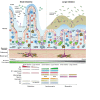Tissue adaptation: Implications for gut immunity and tolerance
- PMID: 28432200
- PMCID: PMC5413340
- DOI: 10.1084/jem.20162014
Tissue adaptation: Implications for gut immunity and tolerance
Abstract
Tissue adaptation is an intrinsic component of immune cell development, influencing both resistance to pathogens and tolerance. Chronically stimulated surfaces of the body, in particular the gut mucosa, are the major sites where immune cells traffic and reside. Their adaptation to these environments requires constant discrimination between natural stimulation coming from harmless microbiota and food, and pathogens that need to be cleared. This review will focus on the adaptation of lymphocytes to the gut mucosa, a highly specialized environment that can help us understand the plasticity of leukocytes arriving at various tissue sites and how tissue-related factors operate to shape immune cell fate and function.
© 2017 Faria et al.
Figures


References
-
- Arstila T., Arstila T.P., Calbo S., Selz F., Malassis-Seris M., Vassalli P., Kourilsky P., and Guy-Grand D.. 2000. Identical T cell clones are located within the mouse gut epithelium and lamina propia and circulate in the thoracic duct lymph. J. Exp. Med. 191:823–834. 10.1084/jem.191.5.823 - DOI - PMC - PubMed
-
- Bain C.C., Scott C.L., Uronen-Hansson H., Gudjonsson S., Jansson O., Grip O., Guilliams M., Malissen B., Agace W.W., and Mowat A.M.. 2013. Resident and pro-inflammatory macrophages in the colon represent alternative context-dependent fates of the same Ly6Chi monocyte precursors. Mucosal Immunol. 6:498–510. 10.1038/mi.2012.89 - DOI - PMC - PubMed
Publication types
MeSH terms
Grants and funding
LinkOut - more resources
Full Text Sources
Other Literature Sources

